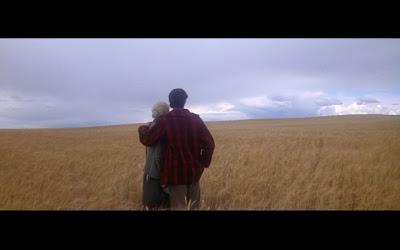The Red Riding Trilogy consists of three made-for-TV movies produced in 2009 by the BBC, entitled Red Riding: 1974, Red Riding: 1980, and Red Riding: 1983. Directed by talented feature film directors and starring quite a cast of experienced British actors, they were so highly acclaimed in the UK that they were given theatrical releases in Europe and America in 2010. They were hyped quite a bit here at the beginning of the year, but they seem to have been mostly forgotten by end-of-year list-makers. They are well worth seeking out, however, as a dense, disturbing trilogy of British neo-noirs, with atmosphere that will seep into you brain and stay there.
The films are based on a series of novels by David Peace. (There are actually four novels, but Nineteen-Seventy-Seven wasn't filmed.) The books are reportedly even more dark, brutal, and despairing than the films, and that's saying something. The plot centers on corruption in the West Riding, Yorkshire, police department, as the community is haunted by at least two different serial killers who go uncaught for several years. The stories are inspired by the real place, and certain actual events including the Yorkshire Ripper murders and documented police cover-ups from the era. The movies take some major liberties with history, however, depicting a police force as corrupt and evil as any on earth, bearing more resemblance to the KGB or the Mafia than actual British coppers. The main conspirators repeatedly lift their glasses in a toast, saying, "To the North, where we do what we want!" The corruption eventually becomes so all-consuming that it becomes unbelievable, at lest for this viewer, though it's depicted so powerfully that it's ultimately forgivable. And the British critics, apparently, did not find it difficult to believe. The depiction of Yorkshire in the '70s and '80s, apart from a few of the dirtier details, is apparently highly accurate, and it's fairly horrifying. The quirky pastoral hamlets of James Herriot All Creatures Great and Small novels this ain't.
The first film (directed by Julian Jarrold) includes the biggest star-making turn of the trilogy, with Andrew Garfield as a young reporter who thinks he's a hotshot but is sadly mistaken. He's out to discover the story behind the disappearances/murders of several young children in the area, including the body of a young girl found with swan wings stitched into her back. A classic noir hero at 20 instead of the more traditional 40, he drinks hard, chain smokes, and looks at the world with the cynicism of a big city reporter. Unfortunately, that cynicism turns out to be dramatically optimistic, and his belief in justice is tragically naive. He wanders the tribalist, poverty stricken and rotten world of Yorkshire, mouthing off to authority figures and getting beaten up repeatedly, like Philip Marlowe in bellbottoms and leather jacket. And his fatal weakness is, as always, a woman; in this case, the mother of one the murdered girls. Unfortunately, this woman (played by Rebecca Hall) is terribly under-written, and while they tumble into bed several times, their attraction never makes much sense. Her actions and motivations, even after the end, are always clouded and never more than guessed at leaving her nothing but plot figure and not a real character. This is one of the flaws of the series as a whole, that many characters feel under-written and they lack the depth we want need to maintain interest. Instead, the trilogy focuses on atmosphere and labyrinthine plot maneuvers, which it happily does very well.
1980 (directed by James Marsh of Man on Wire) is also an accomplished film, dealing with the actual Yorkshire Ripper and starring Paddy Considine as a cop investigating other cops. The police force has really been trying to find the Ripper, but they also wish to blame him for other murders which do not fit his MO, and they avoid following up sources which may take them toward their own deep-seated corruption. Considine tries to get to the bottom of this while also managing his marriage and a dormant affair with his female partner. This film, though, is more low-key than the others--though perhaps more believable--and it's rather forgettable compared to the first and last segments. It furthers the plot and provides lots of important details, but as a movie it offers few thrills or answers.
Overall, the trilogy's strongest trait is its atmosphere, always dank and dirty-looking, with hidden depths to every shadow. This is not to say the films look alike, however, for they are each shot by different directors and cameramen, and on different film stock to boot. The films change as the eras change, the first film mostly an ugly '70s green, the second full of black shadows, while the third reflects a more prosperous 1980s with clearer brighter blues and real sunlight instead of clouds. I was nevertheless rather irritated by the editing. There was far too much of it, especially in the 1974. Shots were never allowed to breathe, everything had to be chopped up into tight, moving close-ups. The whole trilogy could have benefitted from more restrained composition; step back and let foreboding fill up the silences. As good as it is, these films also made me appreciate David Fincher's Zodiac even more. He tells a very similar story there (hunt for a serial killer at large in the '70s), but he manages to give us an enormous amount of details and incident in less than 3 hours, keeps everything coherent, and frames every shot to perfection. Red Riding is a worthy trilogy, but it clearly lives in Zodiac's shadow.
(As a post script, I should note the excellent performances of Sean Bean, Sean Harris, Peter Mullan, and Robert Sheehan, who each create powerfully memorable characters despite limitations. They, along with Garfield and Morrissey, make by far the biggest impressions out of the massive cast.)
Rating: 8/10 Stars.



















